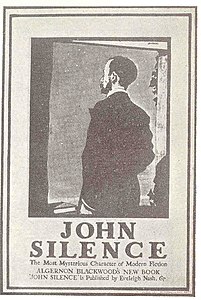Occult detective fiction
This article has multiple issues. Please help improve it or discuss these issues on the talk page. (Learn how and when to remove these template messages)
|

| Fantasy |
|---|
| Media |
|
| Genre studies |
|
| Subgenres |
|
| Fandom |
| Categories |
Occult detective fiction is a
History
Literature
Fitz James O’Brien’s character Harry Escott is a contender for first occult detective in fiction. A specialist in supernatural phenomena, Escott investigates a ghost in "The Pot of Tulips" (1855) and an invisible entity in "What Was It? A Mystery" (1859). The narrator of Edward Bulwer-Lytton’s novella "The Haunted and the Haunters; or, The House and the Brain" (1859) is another student of the supernatural who probes a mystery involving a culprit with paranormal abilities. Sheridan Le Fanu's Dr. Martin Hesselius appeared in "Green Tea" (1869) and later became a framing device for Le Fanu's short story collection In a Glass Darkly (1872).
For most of its plot, The Hound of the Baskervilles, one of Sherlock Holmes's most well-known adventures, seems to belong in this genre. However, by the story's end, the villain turns out to be completely human and mundane, who deliberately created this misleading impression.
The next prominent figure in this tradition was Dr.
Sax Rohmer's collection The Dream Detective features the occult detective Moris Klaw, who utilises "odic force" in his investigations. The occultist Dion Fortune made her contribution to the genre with The Secrets of Dr Taverner (1926), consisting of psychic adventures of the Holmes–like Taverner as narrated by his assistant, Dr Rhodes. Aleister Crowley's Simon Iff featured in a series of stories, some of which have been collected in book form. Dennis Wheatley's occult detective was Neils Orsen.
In Poland Włodzimierz Bełcikowski created two stories (W walce ze Złotym Smokiem - In Battle with Golden Dragon - 1925; Tajemnica wiecznego życia - The Secret of Eternal Life - 1926) about William Talmes (Holmes' rip off but with occult/parapsychic powers and inventor's skills) battling murderous oriental sect and psychic vampire from Atlantis.
Though never large, the occult detective subgenre grew to include such writers as
Modern writers who have used the occult detective theme as a basis for supernatural adventures include Peter Saxon (The Guardians series), John Burke (Dr Alex Caspian), Frank Lauria (Dr Owen Orient), Lin Carter (Anton Zarnak), William Massa (Occult Assassin, The Paranormalist, Shadow Detective, Spirit Breakers) and Joseph Payne Brennan (Lucius Leffing).
The occult detective theme has also been used with series characters devised by such contemporary writers as
A useful recent anthology collecting specimens of the genre is
The magazine Occult Detective Quarterly (Electric Pentacle Press, 2016) specialises in presenting a wide range of new occult detective tales set in a range of time periods, with the occasional pastiche of classic figures from this branch of fiction. ODQ moved to Ulthar Press in 2017. On the tragic death of Sam Gafford of Ulthar Press, it was decided that editors, John Linwood Grant & Dave Brzeski, would continue the magazine under the revised title of Occult Detective Magazine from #6 onward. It is now published by Cathaven Press in the UK. It seemed somehow fitting that refugees from Ulthar should go to Cathaven.
-
Algernon Blackwood's Dr. John Silence
-
Norbert Sevestre's Sâr Dubnotal
-
Sax Rohmer's Moris Klaw
-
Seabury Quinn's Jules de Grandin
Film and television
In the 1970s, there were a number of attempts at occult detective
Other examples include
The most successful effort of this period was the short-lived television series, Kolchak: The Night Stalker (1974–75), starring Darren McGavin; the weekly series was based on two backdoor pilots (The Night Stalker and The Night Strangler) produced by Dan Curtis and scripted by Richard Matheson, based on an unpublished work by Jeff Rice. Kolchak's adventures have been continued in books by Rice and in the comic book Kolchak Tales. Matheson's Kolchak Scripts have also been published.
The
More recent examples include:
Angel Heart,
The Believers,
Blood Ties,
Constantine,
The Dresden Files,
Dylan Dog: Dead of Night,
The Exorcist III,
Forever Knight,
Grimm,
Lord of Illusions,
Lucifer,
The Ninth Gate,
!Oka Tokat,
Penny Dreadful,
R.I.P.D.,
Special Unit 2,
Split Second,
Comics, manga, and anime
The comic book
Other examples of occult detectives in comic books include
Examples in manga and anime include
Video and computer games
- Alpha Polaris
- Amnesia series
- Asylum
- The Adventures of Dog Mendonça & Pizzaboy
- Barrow Hill series
- Barrow Hill: Curse of the Ancient Circle
- Barrow Hill: The Dark Path
- Betrayer
- The Black Mirror series
- The Black Mirror
- Black Mirror II: Reigning Evil
- Black Mirror III: Final Fear
- Black Mirror
- Blackwell series
- The Blackwell Legacy
- Blackwell Unbound
- The Blackwell Convergence
- The Blackwell Deception
- The Blackwell Epiphany
- Call of Cthulhu
- Call of Cthulhu: Dark Corners of the Earth
- Clive Barker's Undying
- Clock Tower series
- Condemned series
- Cryostasis: Sleep of Reason
- D4: Dark Dreams Don't Die
- Daemonica
- Dark Fall series
- Dark Seed series
- Darkness Within series
- Dead Reefs
- Discworld_Noir
- Dracula series
- Echo Night series
- Gabriel Knight series
- Gabriel Knight: Sins of the Fathers
- The Beast Within: A Gabriel Knight Mystery (also known as Gabriel Knight 2: The Beast Within)
- Gabriel Knight 3: Blood of the Sacred, Blood of the Damned
- Ghost Trick: Phantom Detective
- Gray Dawn
- The Lost Crown series
- Megatenseries
- Memento Mori series
- Memento Mori
- Memento Mori 2
- Murdered: Soul Suspect
- Necronomicon: The Dawning of Darkness (also known as Necronomicon: The Gateway to Beyond)
- Nocturne
- Pathologic
- Penumbra series
- Phantasmagoria
- Phantasmagoria
- Phantasmagoria: A Puzzle of Flesh (also known as Phantasmagoria 2)
- Return of the Obra Dinn
- Rhiannon: Curse of the Four Branches
- Sanitarium
- Scratches
- Shadow of Memories
- Silverload
- Stygian: Reign of the Old Ones
- The Vanishing of Ethan Carter
- The Wolf Among Us
- The X-Files Game
See also
References
- ^ Barnett, David (June 30, 2010). "Thomas Carnacki, king of the supernatural detectives". The Guardian. Retrieved March 14, 2011.
- ISBN 978-1-4654-5357-0.
- ISBN 978-0-7566-6742-9.)
In his first series, the Phantom Stranger often made his appearances to debunk supernatural-seeming events, and the inaugural issue established this theme from the outset with stories...from writer John Broome and artist Carmine Infantino.
{{cite book}}:|first2=has generic name (help)CS1 maint: multiple names: authors list (link - ISBN 978-0313337802. p. 585-586
- ^ Baker-Whitelaw, Gavia. "Constantine and Castiel fans square off over 'Hellblazer's angelic fashion". The Daily Dot. March 15, 2012
- ^ Gustafson, Sarah (10 September 2014). "Constantine: NBC drama brings the hellfire from its premiere episode". Channel Guide. September 10, 2014
- ^ Callahan, Timothy. "When Worlds Collide". Comic Book Resources. August 16, 2010
- ^ Cronin, Brian. "Comic Book Easter Eggs – John Constantine Edition". Comic Book Resources. November 13, 2012




